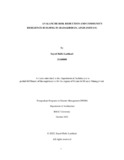Avalanche risk reduction and community resilience building in (Badakhshan, Afghanistan)

View/Open
Date
2022-10Publisher
Brac UniversityAuthor
Lashkari, Sayed HafizMetadata
Show full item recordAbstract
Badakhshan province is one of Afghanistan's mountainous provinces, located in the northeast.
During the winter, most of the country's villages are blanketed in heavy snow, which has an impact
on people's lives, property, livestock, and agriculture. Based on the review of the literature, an
avalanche in the eastern section of Badakhshan province killed 42 people and injured many more,
according to the provincial governor's office. According to the Red Crescent's director, avalanches
killed more than 60 people in 2012. This research aims to assess the vulnerability of avalanches,
to develop an avalanche risk reduction plan and a reliable early warning system. Furthermore, to
evaluate the community’s capacity to tackle Avalanche Hazard in the study area.
The online survey was conducted with the government and non-government organizations.
1Respondents were divided into two groups: government officials such as the NDMA and NGOs
working at the provincial and local levels; all processes were conducted by phone and email and
Community members who live in avalanche-prone areas, academia, and society. After analyzing
all the provided data, the result showed that the level of vulnerability has gradually decreased by
getting knowledge and better awareness about the risk of avalanche in the study area.
In conclusion, these findings imply that communities are mostly unaware of the disaster's
implications. Furthermore, most houses will not have enough food, water, or fuel during the
avalanche disaster if no immediate response is provided. The main issue confronting avalanche
risk reduction and Community resilience Building to failure is the region's security condition;
nonetheless, non-governmental organizations are working to lower avalanche risk in Badakhshan
province.
